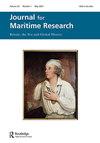第二次世界大战中大西洋和太平洋的潜艇战和情报:两个对手的比较和教训
Q3 Arts and Humanities
引用次数: 6
摘要
一项独特的研究利用官方解密的数据,研究了第二次世界大战期间在两个不同的海洋中潜艇性能和对策的影响。这一分析是针对两个不同的战斗区域,基本上同时使用相同的进攻技术(潜艇)和防御策略(情报和信号解码)。之前的研究表明,在对手之间的冲突中,学习曲线存在于损失率中。这份分析报告首次比较了德国潜艇在大西洋攻击盟军船队的表现,以及美国潜艇在太平洋攻击日本船只的表现。对于这两个冲突战区,目标船的沉没率进行了评估,因此包括“通信情报”(Comint)和“解密情报”(DI)的有效性。推导并证明了相关风险暴露度量的选择。令人惊讶的是,在这两个截然不同的海洋中作战的潜艇舰队所取得的战争沉没率没有发现差异。这种相似性一定是由于常见的随机搜索和人类学习技术,而不是由于采用不同的Comint和DI技术。这一结果对当今战争研究和搜索理论具有重要意义。本文章由计算机程序翻译,如有差异,请以英文原文为准。
Submarine warfare and intelligence in the Atlantic and Pacific in the Second World War: comparisons and lessons learned for two opponents
ABSTRACT A unique study has been undertaken examining the impact of submarine performance and countermeasures in two different oceans during the Second World War using official declassified data. This analysis is for two distinct zones of combat, using essentially and simultaneously the same offensive technology (submarines) and defensive strategies (intelligence and signal de-coding). It has been previously shown that learning curves are present in the rate of losses in conflicts between opponents. This analysis compares for the first time the performance of German submarines in the Atlantic attacking Allied convoys with that of American submarines operating in the Pacific against Japanese shipping. For these two theatres of conflict, the rates of sinking of target ships are evaluated, which therefore includes the effectiveness of ‘communications intelligence’ (Comint) and ‘decryption intelligence’ (DI). The choice of the relevant risk exposure measure can be derived and proved. Surprisingly, no difference was found in the warfare sinking rates achieved by the submarine fleets operating in these two vastly different oceans. This similarity must be due to common random search and human learning techniques, and not to employing differing Comint and DI technology. This result has significance to present-day warfare studies and to search theory.
求助全文
通过发布文献求助,成功后即可免费获取论文全文。
去求助
来源期刊

Journal for Maritime Research
Arts and Humanities-History
自引率
0.00%
发文量
0
期刊介绍:
The Journal for Maritime Research ( JMR ), established by the National Maritime Museum in 1999, focuses on historical enquiry at the intersections of maritime, British and global history. It champions a wide spectrum of innovative research on the maritime past. While the Journal has a particular focus on the British experience, it positions this within broad oceanic and international contexts, encouraging comparative perspectives and interdisciplinary approaches. The journal publishes research essays and reviews around 15-20 new books each year across a broad spectrum of maritime history. All research articles published in this journal undergo rigorous peer review, involving initial editor screening and independent assessment, normally by two anonymous referees.
 求助内容:
求助内容: 应助结果提醒方式:
应助结果提醒方式:


